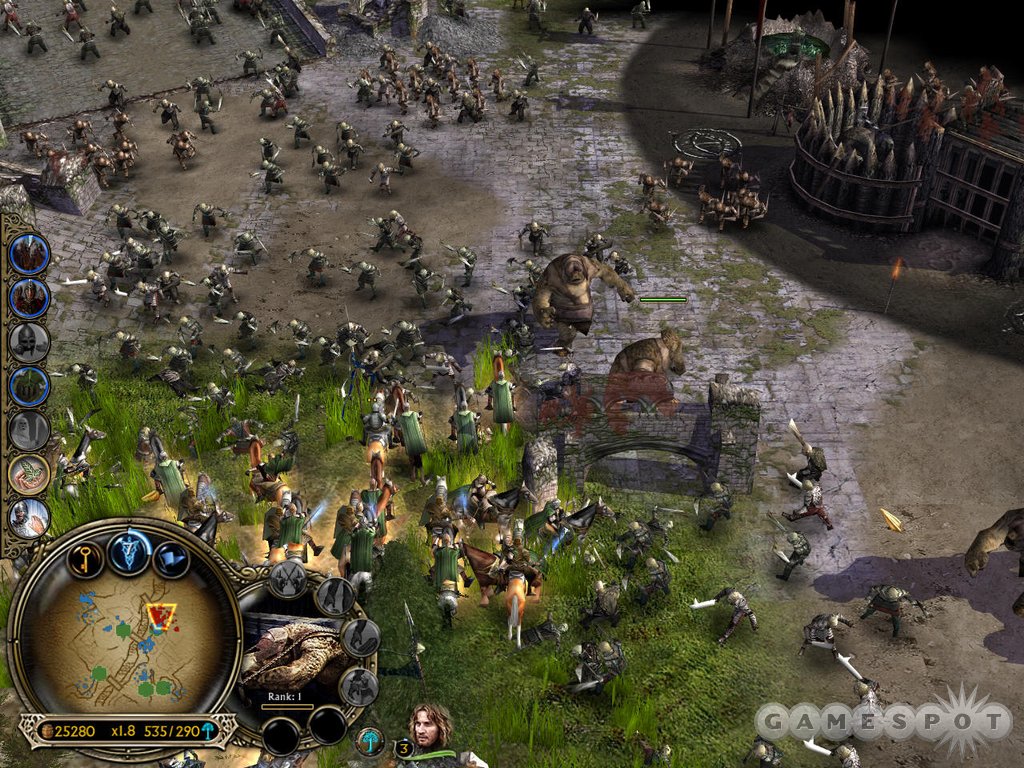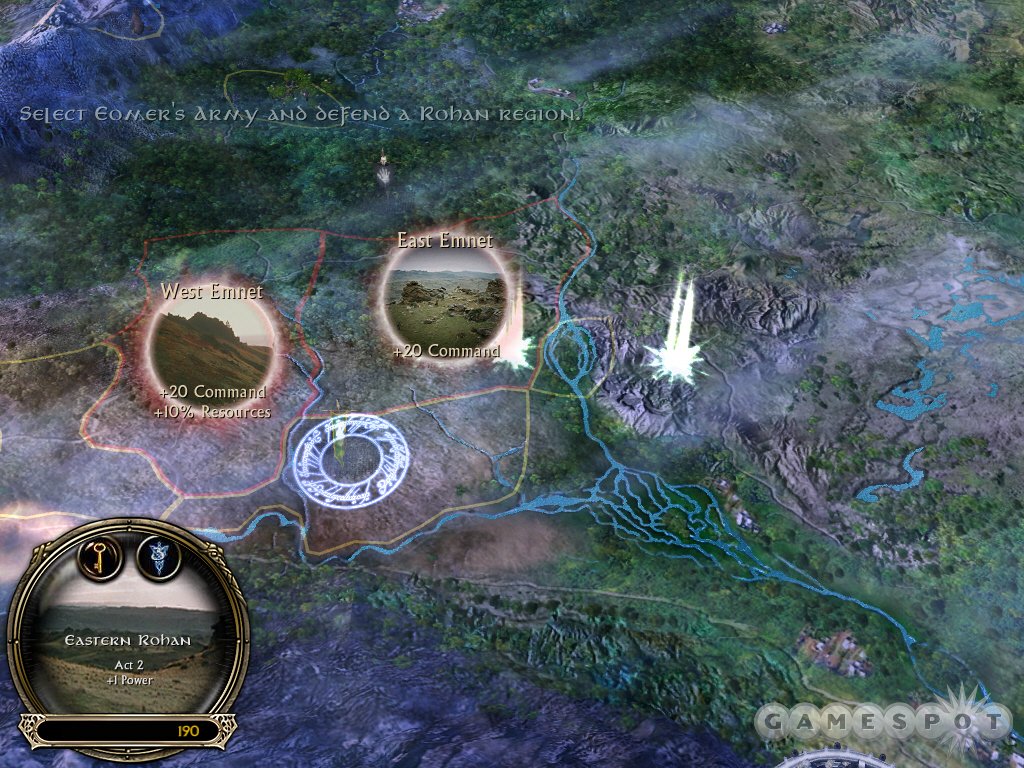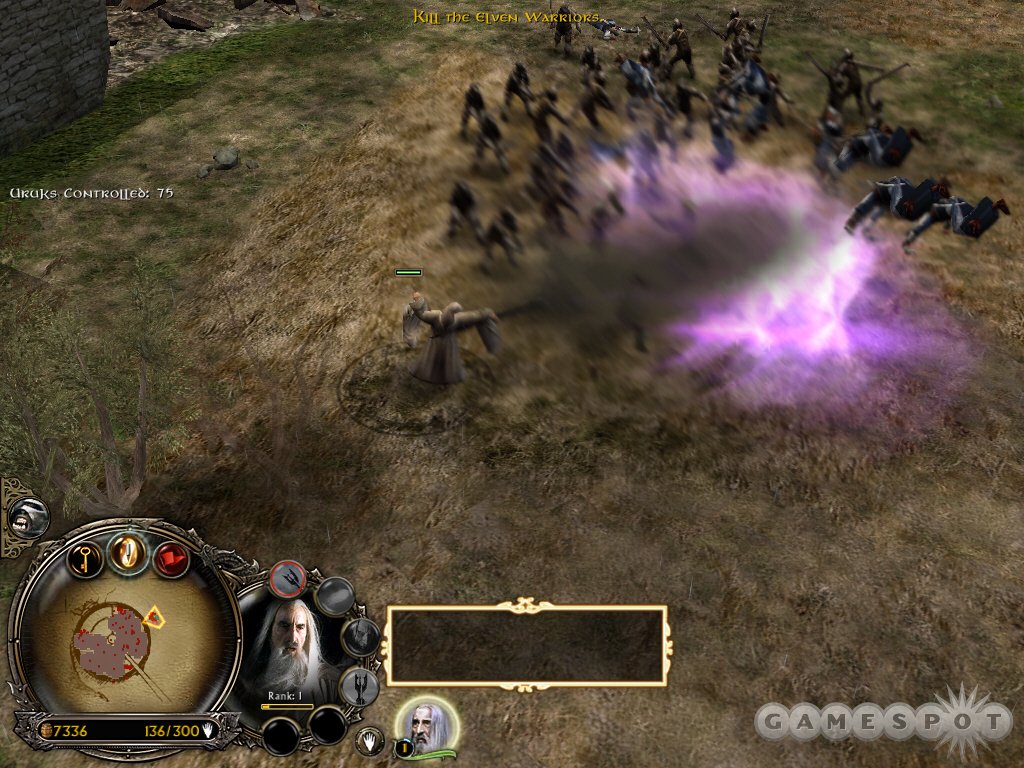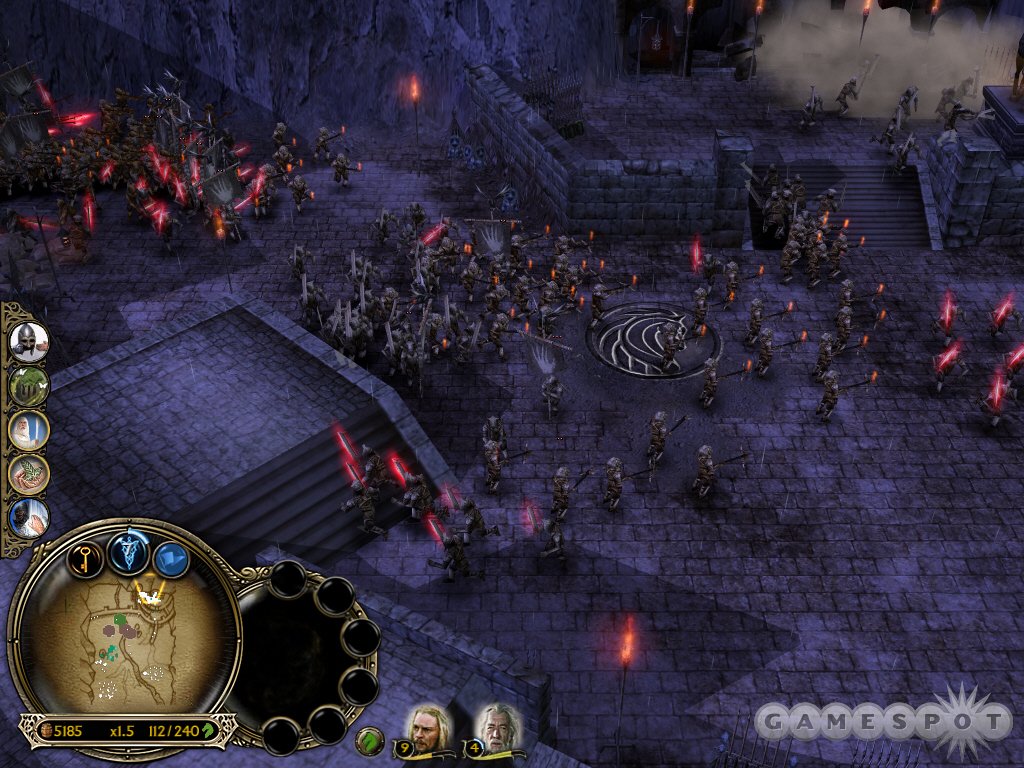Gandalf didn't "die" in Moria. In fact, the old wizard slapped down the Balrog and marched out of the mountain with the rest of the fellowship. Meanwhile, King Theoden of Rohan managed to get cut down at Helm's Deep and, oh yeah, Boromir lives. Is this revisionist fantasy history at work? No, it's just a campaign as the good guys in The Lord of the Rings, The Battle for Middle-earth, EA's real-time strategy game that spans the entire saga of Peter Jackson's The Lord of the Rings movies. The Battle for Middle-earth has a lot going for it: This is a big game packed with beautiful graphics and two huge campaigns. And while it doesn't achieve the same epic sense of scale as Jackson's movies, it's still an engrossing and well-made real-time strategy game that captures the essence of J.R.R. Tolkien's wondrous world.

While some might have expected that The Battle for Middle-earth would rival the size and scope of a certain other major real-time strategy game released this year, the truth is that it's more on the scale of traditional real-time strategy games, though its battles are still quite big. What makes The Battle for Middle-earth work is the fact that it allows you to rewrite the history of the War of the Ring as either the forces of good or the forces of evil. The game does this by combining an overarching turn-based campaign that's stitched together with real-time strategy missions, allowing you to decide where to take the fight to next. This way, you can control the armies of good or evil as you march across the world of Middle-earth, conquering province after province along the way.
At the heart of the campaign game is the living world map, which is exactly what it sounds like. This is a 3D view of a living, breathing Middle-earth, divided into more than 30 provinces, each of which has special properties that you earn when you control it. One province may give you bonus resources, another will give you power points that you can use to invest in powerful abilities, and yet another will give you extra command points, allowing you to lead more troops in battle. And as you gaze upon the living world, with its little details like the Nazgûl flying through overcast skies, the sonorous tones of Ian McKellen or Christopher Lee (both reprising their roles from the movies) will guide you.
Admittedly, the strategic layer of the campaign is a bit thin. You have only two or three armies at your disposal, and the goal isn't so much to crush the opposing army as it is to simply conquer as many provinces at possible. When you select an army, the game will highlight any adjacent hostile provinces, and you'll select which one you want to attack next. You'll then drop down into the real-time portion of the game to resolve the battle. Once that's done, you'll switch back to the campaign map to do it all over again. There doesn't appear to be any hurry to get anywhere, either, as the final battle for both sides can wait until you're ready to proceed. That means you can spend time mopping up isolated provinces and building up your forces.

The strategic map does incorporate some welcome features, such as continuity between missions. In other words, the army that you have at the end of one battle is the same army you'll have at the beginning of the next. This not only gives you an added incentive to preserve your units, but, more importantly, it also allows both your heroes and your regular units to rise in experience level, making them even more powerful than before. And, in a nice touch, you can rename your regular units to give them some personality. It's easy to turn a noted cavalry unit into the Light Brigade, for instance. This also makes it easier to recognize which units on the battlefield you want to preserve.
Like in other conventional real-time strategy games, there are some missions in Battle for Middle-earth that require you to navigate through a level with a handful of units, usually heroes, without building anything. These can be some of the more-annoying missions in the game, mainly due to the fact that the game is at times wildly inconsistent when it comes to handling hero death. For example, while controlling the fellowship through Moria, none of the fellowship may die. If someone does, you'll fail the mission and have to reload the battle. But in other battles, heroes can and will fall. In fact, one of the most shocking moments in our testing came when Aragorn fell in an early battle and the game went on, accepting Aragorn as a casualty of war. Another surprise came when Boromir was saved from the Uruk-hai, thus veering away from The Fellowship of the Ring storyline. Alas, what seemed to be a bold move on the part of EA faded as Aragorn and other characters that were killed in battle simply reappeared in other battles later on. Though this seems necessary from a narrative point of view (after all, someone has to summon the Army of the Dead to fight at Minas Tirith), it makes parts of the campaign's storyline a little hard to swallow.

Part of the problem with the heroes is that they walk the line between usefulness and inconvenience. The major characters from the movies, such as Aragorn, the four hobbits, Gollum, and Eowyn, are available as heroes in the game. They're fairly powerful, but not powerful enough to overwhelm and unbalance the game. And, as they gain experience, they unlock more-powerful abilities. Gandalf has a wicked magic blast that hurls enemy battalions into the air, while Aragorn can summon the power of Elendil to cause enemies to flee. But these special characters are still vulnerable, and in the sheer chaos of battle, it's difficult to manage regular units alongside multiple heroes and their powers. It's easy to lose track of heroes, and often they can get cut down in battle. Thus, you'll feel it's easier simply to put them in the rear, where they can stay safe and out of the way. Unfortunately, they also won't accrue experience sitting in the back, and late in the campaign you may find yourself in a tight spot if your heroes aren't strong enough. In fact, there are some late-campaign battles where a high-level hero can be the difference between success and failure.
The real-time battles of The Battle for Middle-earth are the heart of the game, and while they may not provide the same epic sense of scale as the battles in the movies, they're still quite well done. The game captures the many different moments from the movies very well, from the way cavalry can slice through enemy infantry like a hot knife through butter, to the sheer numbers of the forces of evil.
What's really interesting is how The Battle for Middle-earth fits so effectively into the existing storylines of the movies. For instance, near the beginning of The Two Towers, we see Eomer leading a company of horsemen. By the end of that movie, he arrives at Helm's Deep with an army of horsemen behind him to save the day. In The Battle for Middle-earth, you can lead Eomer throughout his campaign in Rohan, building up a larger and larger army behind him. Then, when you must fight the battle of Helm's Deep, you must hold out long enough for Gandalf and Eomer to arrive, at which point the army that you built up with Eomer arrives with him. It's a nice sense of continuity that helps fill out the background of the movies, and it's also an example of the way the game rewards you for playing wisely and preserving your force.

The game doesn't rely on randomly generated maps, so each province has a distinct look and feel to it, from the forest-dominated Entwash to the plains of Gondor. The battles require you to construct bases and gather resources, but the game offers some nice twists on the convention. First of all, you can't simply build sprawling rear bases to pump up your economy and churn out hundreds of units. The game restricts where you can build to certain parts of the map, and each location will allow you to construct only so many buildings. There aren't any resources that you actively mine or gather, either, so you won't see dozens of peasants running back and forth. Instead, the game relies on a rather generic universal resource that you accrue by building farms and slaughterhouses, but these structures are also limited to certain points on the map. And, once again, the game rewards you for past performance, as you benefit from the various bonuses that you earn by conquering different provinces. So, by the late game, you may have easily doubled your resource rate from the beginning.
There are four playable armies in the game, representing the four major factions of the movies, and they play a bit differently from each other. On the side of good, the Rohan are the supreme cavalry in the game, whereas Gondor specializes in defensive fortifications (the siege of Minas Tirith is, like in the movies, one of the best moments in the game). On the opposite end, Mordor can produce a seemingly endless number of Orcs, whereas Isengard can deploy the fearsome Uruk-hai. Each side feels just right and captures the faction's look from the movies, from the building architecture to the unit design. And the designers didn't have to gin up new units to pad out each army (which usually rings a false note in movie-based games), as the many different units from the movies are more than enough to fill out the game.

Most units come in battalions, which consist of several smaller units grouped together. The battalion system allows you to control large numbers of troops relatively easily. As noted before, as battalions gain experience they become more powerful, meaning they'll become much more effective in battle, and you'll regularly have the opportunity to upgrade their weapons and equipment, making them even more fearsome. The game also features an "emotion system," which seems like it reflects the morale of your units, but is really more for show than anything else. For example, a group of soldiers will cower briefly at the approach of a fearsome troll. However, your troops will still charge into the fight at full strength if ordered. The way your soldiers alternately cower and cheer has a negligible effect on the gameplay overall, because troops don't actually bolt if the fight is going badly, which means that every battle is a to-the-death affair, unless you dictate otherwise.
This is indicative of perhaps the biggest weakness of the game: Most skirmishes are simply gigantic battles of attrition, in which you slowly attempt to wear down the other side. Despite attempts to limit the number of buildings, this is still mainly a battle of economic production. There are a few missions where a quick strike at the beginning can win the day, but most of the time the game falls back to a slower pace as you try to take over strategic locations on the map and fortify them, and then repeat the process over and over.
Two key features in the game are the One Ring and Evenstar powers. Certain provinces will reward you with power points, which you can use to purchase these powers. They include the ability to summon a group of Elven allies or a Balrog to the battlefield--effects that can shift the momentum of the conflict in your favor. Once used, these powers must recharge, so you can deploy them only sparingly. When on the attack, you can usually win a fight for a strategic location by unleashing all the powers at once, and then simply concentrate on holding that spot while the powers recharge.
This works in part because the game's artificial intelligence is easy to manipulate. For example, a strategy that works repeatedly is to build a defensive strongpoint and then watch the enemy waste its best units trying to overrun it. The AI knows instantly when your units sortie outside of a fortress, and it will automatically dispatch its units to attack them. So all you have to do is park a handful of units outside your base and watch as the enemy sends its troops headlong into your defensive meat grinder in an attempt to reach them.
The two campaigns of The Battle for Middle-earth are both quite big, so don't be surprised if a single campaign consumes more than 30 hours. Whereas most scripted real-time strategy campaigns run about 10 to 12 missions in length, a campaign in Battle for Middle-earth will easily run 20 to 30 missions. And when you're done with those, you can look forward to the skirmish and multiplayer portions of the game, which use the existing campaign battlefields (although it would be nice to have some additional skirmish maps, simply for variety's sake). Both of these components are fun and let you set up some unusual matchups, such as Gondor versus Rohan or Isengard versus Mordor. Skirmishes are fairly straightforward and not unlike the campaign battles, but with multiplayer, you have the cunning and unpredictability of a human opponent to contend with. You can set up a battle with up to eight players in a free-for-all or divided into teams. EA also deserves credit for its new player-matching browser for online games, which automatically searches for an opponent based on latency and relative skill level, so you don't have to take your chances with open play sessions.
The Battle for Middle-earth is also a beautiful real-time strategy game, with tons of great graphical detail and effects. Everything from the gameworld to the huge battles looks good, and you'll notice little details like a blur effect in explosions, or the way the giant eagles swoop down to tear chunks off buildings. There is a price to pay at times, as the frame rate can slow down during some of the biggest battles, even on fast machines exceeding the recommended requirements--but it's almost worth it to enjoy the grandeur of it all. And, as if you needed a reminder of the source material, every now and then clips from the movie will play in the corner of the screen. It's a bit cheesy, but it does allow you to compare the movie footage with what's happening in the actual game. It's awe-inspiring when you see multiple mûmakil (the giant elephants) lumbering at you, for instance.

The sound effects, voice acting, and music also are first-rate. While EA couldn't get everything, it did get a sizable number of actors from the movie to voice their characters in the game. These include McKellen, Lee, Andy Serkis, Elijah Wood, Sean Astin, and more. Meanwhile, the substitutes for actors like Viggo Mortenson and Orlando Bloom sound close enough to the real things. And binding the entire game together are composer Howard Shore's memorable movie scores, along with the new music that EA had to write to fill out the game. This new music fits right in with Shore's themes, so it's hard to tell where the movie music ends and the game music takes over.
As befits its source material, The Battle for Middle-earth is a huge game, and there's a lot of great gameplay to be had in it. The opportunity to command the forces of good and evil in the War of the Ring and rewrite history is sure to appeal to the many fans of the books and movies. And while some aspects of the game may seem lacking, it's still an enjoyable journey through the lands of Middle-earth--even if Boromir lives.